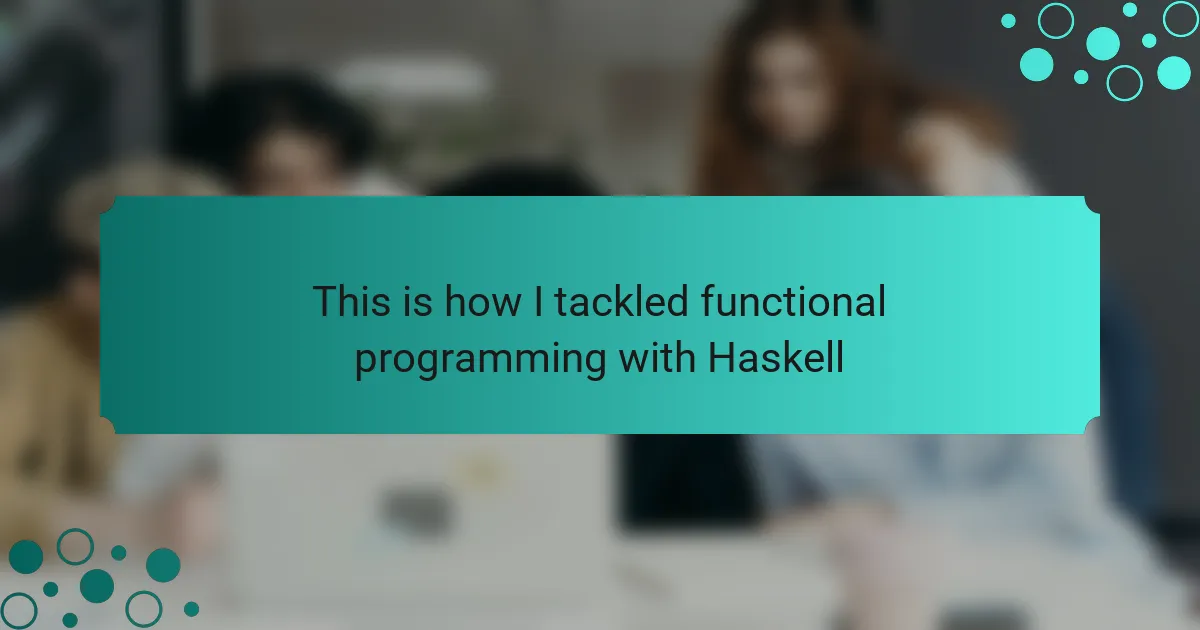Key takeaways
- Functional programming focuses on immutability, pure functions, and first-class functions, leading to cleaner and more predictable code.
- Haskell’s key concepts like lazy evaluation and a strong type system enhance performance and reduce errors at compile time.
- Challenges in learning Haskell often include grasping pure functions and understanding the type system, which ultimately fosters better programming practices.
- Regular practice, engaging with the Haskell community, and exploring libraries can significantly enhance your proficiency and confidence in Haskell programming.
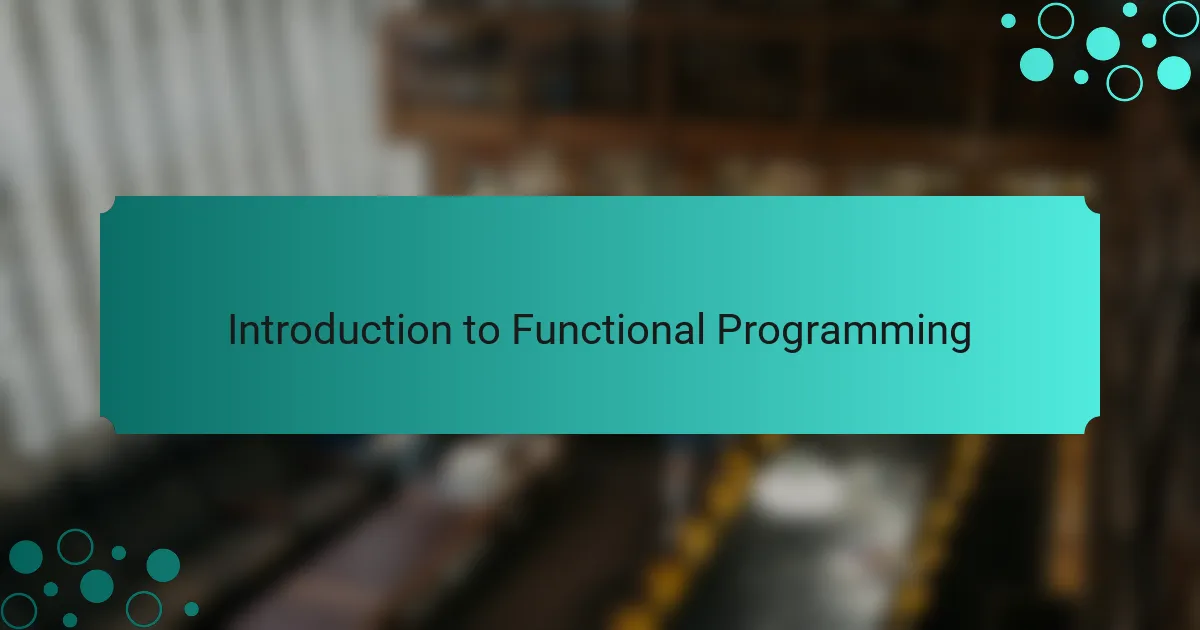
Introduction to Functional Programming
Functional programming is a programming paradigm that emphasizes the use of functions to create software. I remember when I first encountered the concept; it felt like a refreshing change from the imperative programming styles I was used to. Have you ever found yourself lost in a maze of mutable states and side effects? Functional programming offers a different path, focusing on immutability and pure functions, which can lead to more predictable and manageable code.
One of the most fascinating aspects of functional programming is the concept of first-class functions. This means functions can be assigned to variables, passed as arguments, or returned from other functions. It was a game changer for me when I realized I could treat functions like any other data type, opening up a world of possibilities. Have you ever wished for more elegant solutions to complex problems? Embracing this approach often resulted in cleaner and more concise code for me.
In functional programming, recursion becomes a powerful tool, replacing traditional loops. I initially found the idea daunting, but as I practiced, I discovered how elegant and powerful recursive solutions could be. Have you tried using recursion to solve problems? The joy of breaking down a problem into smaller, manageable parts really resonated with me, transforming how I approached challenges in programming.
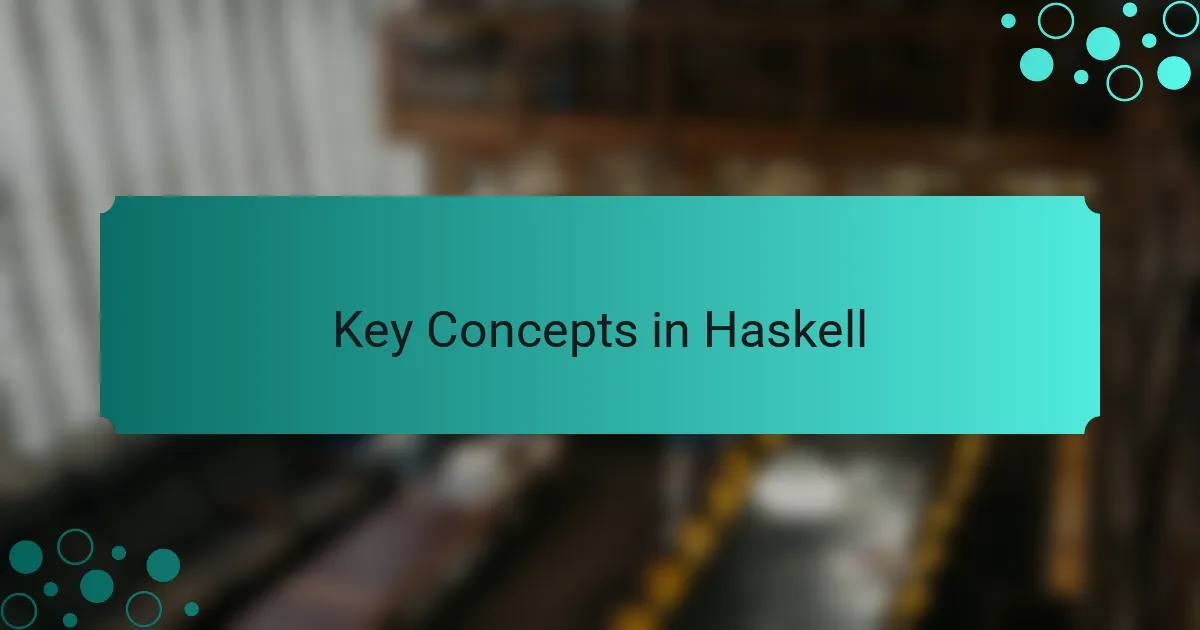
Key Concepts in Haskell
Haskell is a rich functional programming language that emphasizes purity and immutability. One of the key concepts that I found both intriguing and sometimes challenging was the use of first-class functions. It was like a light bulb moment for me when I realized how these functions could be passed around just like any other data type. This allowed me to write more concise and expressive code, which felt empowering.
Another fundamental aspect is the concept of lazy evaluation. Initially, it seemed counterintuitive to me. I wondered how it could be efficient, yet over time, I began to appreciate its benefits. This feature allows programs to run faster and handle infinite data structures, which is a fascinating concept that shifted my approach to problem-solving.
Finally, type systems in Haskell are strong and static, which means that errors can often be caught at compile time. When I first experienced this, it felt like having a safeguard, preventing many potential bugs before they could affect the performance of my code. Understanding these concepts not only made me a better programmer but also deepened my admiration for the elegance of Haskell itself.
| Concept | Description |
|---|---|
| First-Class Functions | Functions can be treated as data, allowing for higher-order functions and more abstract programming. |
| Lazy Evaluation | Expressions are not evaluated until their results are needed, enabling efficient memory use and support for infinite data structures. |
| Strong and Static Type System | Type errors are caught at compile time, enhancing code reliability and reducing runtime errors. |

Setting Up Haskell Environment
Setting up a Haskell environment can be an exciting yet slightly daunting task, especially for beginners. I remember the first time I installed Haskell; I felt a mix of anticipation and uncertainty. To get started, downloading the Haskell Platform or using GHCup is essential, as they streamline the installation process and come with various libraries and tools.
I also found that using an Integrated Development Environment (IDE) like Visual Studio Code with the Haskell extension made a significant difference in my coding experience. It provides features like syntax highlighting and code suggestions, which help make learning Haskell’s functional programming paradigm more manageable.
Here’s a quick comparison table to illuminate the options available when setting up your Haskell environment:
| Method | Features |
|---|---|
| Haskell Platform | Includes GHC, libraries, and tools; suitable for beginners. |
| GHCup | Lightweight installation; allows managing multiple GHC versions easily. |
| Visual Studio Code | Provides enhanced coding experience with autocomplete and linting. |
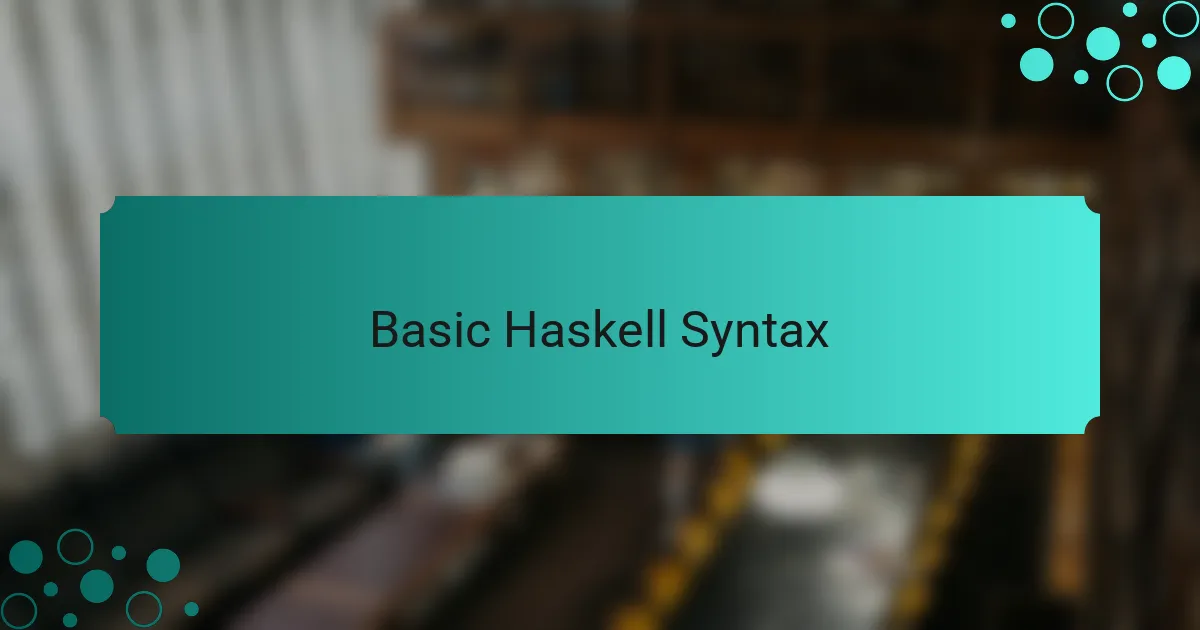
Basic Haskell Syntax
When I first dived into Haskell, the syntax felt quite different from what I was used to. For instance, Haskell’s use of expressions rather than statements really stood out to me. Rather than focusing on executing commands, it emphasizes giving input to functions and obtaining results. This shift required me to adjust my mindset, but it ultimately led to more elegant code.
Another aspect of Haskell’s syntax that captured my interest was its reliance on whitespace for structure. Unlike many programming languages that use brackets or keywords to define blocks of code, Haskell uses indentation to indicate hierarchy and scope. At first, I found this to be a bit challenging; I wondered if I would make formatting errors when I was coding. However, once I got the hang of it, I appreciated the clarity this style brought to my code. Have you experienced the beauty of clean indentation in your code?
Functions in Haskell are defined simply using the syntax functionName arguments = expression. I remember the first function I wrote seemed deceptively straightforward, yet it opened up a world of possibilities. I found myself embracing the idea that even complex operations could often be broken down into smaller functions. This made problem-solving feel less daunting and much more manageable. How have you approached function definitions in your own programming experience?
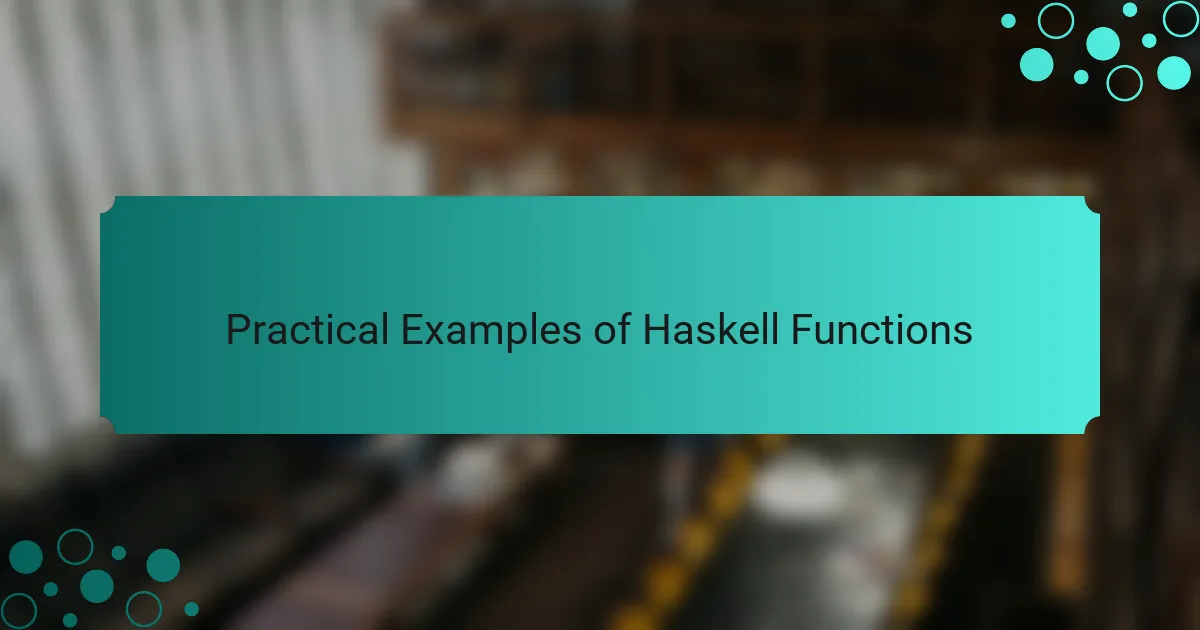
Practical Examples of Haskell Functions
When I first started using Haskell, I was captivated by its powerful functions. I remember struggling a bit with the purely functional paradigm, but once I grasped how functions operate as first-class citizens in Haskell, everything clicked. The beauty of higher-order functions really intrigued me, allowing for more abstract and reusable code.
Here are some practical examples that illustrate the elegance of Haskell functions:
- Map Function: This applies a function to each element in a list. For example,
map (*2) [1, 2, 3]results in[2, 4, 6]. It’s fantastic for transforming data seamlessly! - Filter Function: This is used to select elements from a list based on a condition. For example,
filter even [1..10]gives[2, 4, 6, 8, 10], demonstrating how you can elegantly sift through data. - Fold Function: A powerful tool for reducing a list to a single value. For example, using
foldl (+) 0 [1, 2, 3, 4]sums up to10. This function made me appreciate how Haskell processes data with such a neat approach.
Each of these functions opened my eyes to different strategies in problem-solving, and it felt like I was unlocking new levels in my programming journey. If you’re diving into Haskell, playing around with these functions is a must!

Challenges Faced in Learning Haskell
Learning Haskell came with its fair share of challenges, and I often found myself grappling with the steep learning curve. One of the most bewildering aspects for me was the concept of pure functions. The idea that functions shouldn’t have side effects seemed both liberating and restrictive at first. Have you ever tried to think about your code in such a manner? It gradually forced me to reconsider how I structured programs, leading to more disciplined and predictable outcomes.
Another hurdle was understanding Haskell’s type system. I recall feeling overwhelmed when the compiler flagged numerous type mismatches during my early attempts at coding. Initially, it felt like a barrier rather than a helpful feature. However, with time, I came to appreciate how these strict types worked as a protective layer, catching potential bugs before they ever had the chance to manifest. Does this resonate with you? I’ve found that learning to read and understand type signatures ultimately made me a more confident programmer.
Lastly, I struggled with the concept of laziness in evaluation. It seemed counterintuitive at first—waiting for functions to get evaluated until their results were needed. I remember questioning how postponing computation could lead to efficiency. But once I experienced its benefits firsthand, it was like discovering a new dimension in coding efficiency. Have you had similar experiences with unconventional programming concepts? Embracing these ideas was key to my growth as a Haskell programmer.
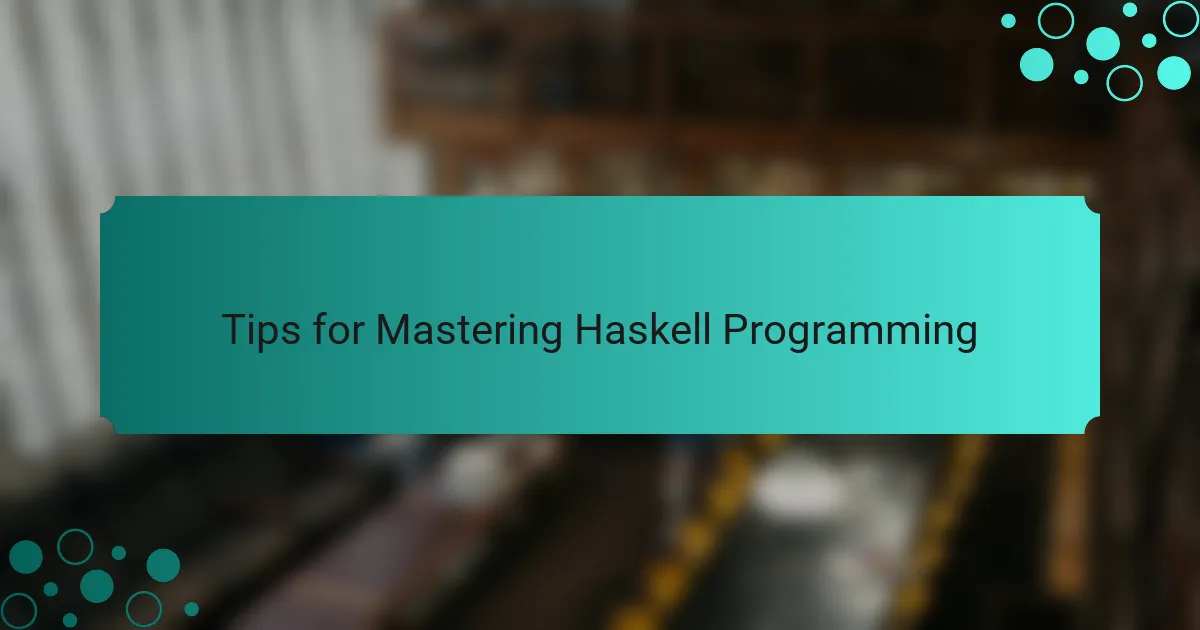
Tips for Mastering Haskell Programming
When mastering Haskell, I found it invaluable to embrace the power of learning through practice. One method that worked wonders for me was solving small coding challenges regularly. I remember diving into sites like Exercism, where I could tackle specific Haskell problems. This approach not only reinforced my understanding of syntax but also allowed me to see concepts like recursion in action. Do you have a favorite platform for practicing coding? Finding the right resource can significantly enhance your confidence and mastery.
Another tip is to leverage the Haskell community. I was pleasantly surprised by how supportive and enthusiastic fellow Haskell enthusiasts were. Participating in forums, attending meetups, or even engaging on platforms like Stack Overflow opened up a treasure trove of knowledge. Those discussions often uncovered tips and tricks that accelerated my learning, and sometimes, simple code reviews helped me grasp complex concepts more clearly. Have you tapped into community support in your learning journey?
Lastly, I suggest experimenting with Haskell libraries and frameworks. When I started exploring libraries like Snap for web development and QuickCheck for testing, it changed my perspective. Not only did these tools showcase the strengths of Haskell, but they also presented real-world applications of the concepts I was learning. Have you ever tried integrating libraries into your projects? Seeing how theory translates into practice can be a satisfying experience that deepens your understanding and enthusiasm for the language.
